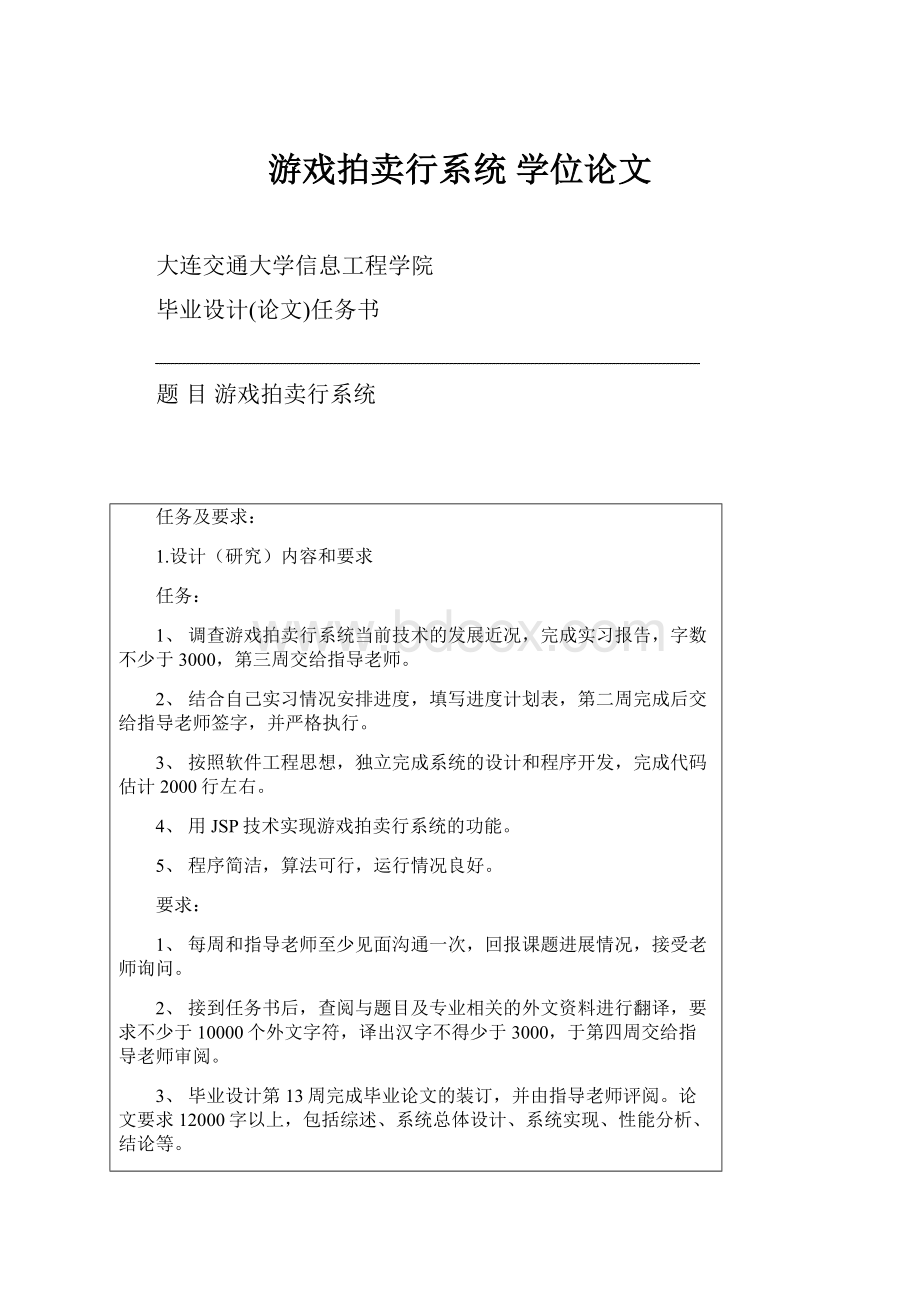游戏拍卖行系统 学位论文.docx
《游戏拍卖行系统 学位论文.docx》由会员分享,可在线阅读,更多相关《游戏拍卖行系统 学位论文.docx(75页珍藏版)》请在冰豆网上搜索。

游戏拍卖行系统学位论文
大连交通大学信息工程学院
毕业设计(论文)任务书
题目游戏拍卖行系统
任务及要求:
1.设计(研究)内容和要求
任务:
1、调查游戏拍卖行系统当前技术的发展近况,完成实习报告,字数不少于3000,第三周交给指导老师。
2、结合自己实习情况安排进度,填写进度计划表,第二周完成后交给指导老师签字,并严格执行。
3、按照软件工程思想,独立完成系统的设计和程序开发,完成代码估计2000行左右。
4、用JSP技术实现游戏拍卖行系统的功能。
5、程序简洁,算法可行,运行情况良好。
要求:
1、每周和指导老师至少见面沟通一次,回报课题进展情况,接受老师询问。
2、接到任务书后,查阅与题目及专业相关的外文资料进行翻译,要求不少于10000个外文字符,译出汉字不得少于3000,于第四周交给指导老师审阅。
3、毕业设计第13周完成毕业论文的装订,并由指导老师评阅。
论文要求12000字以上,包括综述、系统总体设计、系统实现、性能分析、结论等。
4、教学第13周通过中软及教研室组织进行软件验收,验收时要提供软件使用说明书。
5、于第13周提出毕业答辩申请并签字。
6、第14周答辩,要求制作PPT。
2.原始依据
通过大学几年的学习,已经学习了诸如软件工程、数据库原理及应用、数据结构、C++、VisualBasic、JAVA等多门程序设计语言和网络等基础知识和专业知识,学生有能力而且可以独立完成小中型项目的设计与开发。
学校现有设备和环境可以提供给学生实习和上机,而且具有专业老师可以指导学生。
3.参考文献
[1]王诚梅.JSP案例开发集锦[M].北京:
电子工业出版社.2005
[2]吴晓松.国际电子商务发展状况及我国应对策略[J].云南财贸学院学报.2001
[3]军征.闰众.电子商务应用与重构案例分析[M].北京:
高等教育出版社.2003
[4]唐有明.JSP动态网站开发基础练习.典型案例[M].北京:
清华大学出版社.2006
[5]陈兵.网络安全与电子商务[M].北京:
北京大学出版社.2002
[6]池雅庆.JSP项目开发实践[M].北京:
中国铁道出版社.2006
[7]黄明.JSP信息系统设计与开发实例[M].上海:
机械工业出版社.2004
[8]萨师煊.王珊.数据库系统概论[M].北京:
高等教育出版社.2000
[9]陈旭东.刘迪仁编著.JSP2.0应用教程[M].北京:
清华大学出版社.2006.6
[10]叶乃沂.电子商务信息时代的管理与战略[M].上海:
上海交通大学出版社.2002
[11]JuanLipsonVuong.Asemantics-basedroutingschemeforgridresourcediscovery[M].E-Science:
FirstInternationalConferenceonE-ScienceandGridComputing.2005
[12]CayS.Horstmann.GaryCornell[美].《CoreJAVA2Volume1Fundamentals》[M].Pearson.Education.2005-01
指导教师签字:
专业(方向)负责人签字:
2012年3月26日
大连交通大学信息工程学院
毕业设计(论文)进度计划与考核表
学生姓名
李青霖
专业班级
软件工程
08-1班
指导教师
常敬岩
史 原
本课题其他人员
题 目
游戏拍卖行系统
日 期
计划完成内容
完成情况
指导老师检查签字
第1周
完成任务书、提交进度表
第2周
完成调研报告、完成英文翻译
第3周
进行市场调查研究,需求分析
第4周
初步对系统进行分析设计
第5周
系统详细设计,进行编码
第6周
系统编码实施、完成论文初稿
第7周
完成系统编码,进行调试
第8周
系调试统编码、提交论文初稿
第9周
完成系统编码调试、完善毕业论文
第10周
完成撰写毕业设计论文编写及代码测试
第11周
完成论文终稿、准备毕业论文打印、装订
第12周
提交毕业论文终稿及代码
第13周
提交毕业论文成果资料
第14周
毕业论文答辩
指导教师签字:
年 月 日
注:
“计划完成内容”由学生本人认真填写,其它由指导教师考核时填写。
大连交通大学信息工程学院
毕业设计(论文)外文翻译
学生姓名李青霖专业班级软件工程08-1班
指导教师常敬岩 史原职称高工 讲师
所在单位信息科学系软件工程教研室
教研室主任 刘瑞杰
完成日期2012年4月13日
Aclusteringmethodtodistributeadatabaseonagrid
ScienceDirect:
FutureGenerationComputerSystems23(2007)997–1002
Summary:
Clustersandgridsofworkstationsprovideavailableresourcesfordataminingprocesses.Toexploittheseresources,newdistributedalgorithmsarenecessary,particularlyconcerningthewaytodistributedataandtousethispartition.WepresentaclusteringalgorithmdubbedProgressiveClusteringthatprovidesan“intelligent”distributionofdataongrids.Theusefulnessofthisalgorithmisshownforseveraldistributeddataminingtasks.
Keywords:
Gridandparallelcomputings;Datamining;Clustering
Introduction
Knowledgediscoveryindatabases,alsocalleddatamining,isavaluableengineeringtoolthatservestoextractusefulinformationfromverylargedatabases.Thistoolusuallyneedshighcomputingcapabilitiesthatcouldbeprovidedbyparallelismanddistribution.TheworkdevelopedhereispartoftheDisDaMinprojectthatdealswithdataminingissues(asassociationrules,clustering,...)usingdistributedcomputing.DisDaMin’saimistodevelopparallelanddistributedsolutionsfordataminingproblems.Itachievestwogainsinexecutiontimes:
gainfromtheuseofparallelismandgainfromdecreasedcomputation(byusinganintelligentdistributionofdataandcomputation).Inparallelanddistributedenvironmentssuchasgridsorclusters,constraintsinherenttotheexecutionplatformmustbetakenintoaccountinalgorithms.Thenon-existenceofacentralmemoryforcesustodistributethedatabaseintofragmentsandtohandlethesefragmentsusingparallelism.Becauseofthehighcommunicationcostinthiskindofenvironment,parallelcomputingmustbeasautonomousaspossibletoavoidcostlycommunications(oratleastsynchronizations).However,existinggriddataminingprojects(e.g.DiscoveryNet,GridMiner,DMGA[7],orKnowledgeGrid[11])providemechanismsforintegrationanddeploymentofclassicalalgorithmsongrid,butnotnewgrid-specificalgorithms.
OntheotherhandtheDisDaMinprojectintendstotackledataminingtasksconsideringdataminingspecificsaswellasgridcomputingspecifics.Fordataminingproblems,itisnecessarytoobtainanintelligentdatapartition,inordertocomputemoreindependentdatafragments.Themainproblemishowtoobtainthisintelligentpartition.Fortheassociationrulesproblem,forexample,themaincriterionforintelligentpartitionisthatdatarowswithinafragmentareassimilaraspossible(accordingtovaluesforeachattribute),whiledatarowsbetweenfragmentsareasdissimilaraspossible.Thiscriterionallowsustoparallelizethisproblemwhichnormallyneedstoaccessthewholedatabase.Itallowsustodecreasecomplexity(see[2]).Asthisdistributioncriterionappearssimilartotheobjectiveofclusteringalgorithms,thepartitioncouldbeproducedbyaclusteringtreatment.Theusefulnessoftheintelligentpartitionobtainedfromclusteringfortheassociationrulesproblemhasalreadybeenstudied(see[2]).
Clearlytheclusteringphaseitselfhastobedistributedandneedstobefastinordernottoslowdowntheglobalexecutiontime.ClusteringmethodswillbedescribedbeforeintroducingtheDistributedProgressiveClusteringalgorithmforexecutionongrid.
Fig.1.KMeansandagglomerativeclusteringprinciple.
Clustering
Clusteringistheprocessofpartitioningdataintodistinctgroups(clusters)sothatobjectswithinasameclusteraresimilar,butdissimilarfromobjectsinotherclusters.Distinctclusteringmethodscouldbeseparatedconsideringtwokindsofleadingprinciples:
hierarchicalmethodsandpartitioningones.
Hierarchicalmethodsarecomposedofagglomerativeones(thatinitiallyconsiderapartitionwithclustersofauniquedatainstanceandmergeneighbouringclustersuntilaterminationcriterionismet)anddivisiveones(thatinitiallyconsiderapartitionwithoneclusterwhichcontainsalldatainstancesandcutclustersiterativelyuntiltermination).Partitioningmethodsarecomposedbydistance-basedmethods(asKMeans[8]forexample),density-basedmethodsorbasedonprobabilities.Othercriteriapermitustodistinguishbetweenclusteringmethods(see[10]);thosemethodsbasedonmembershipdegreeofdatainstancestoclusters(hardascitedbeforeorfuzzy(see[4])),andincrementalmethodsforwhichdatainstancesareconsideredwhenavailableinsteadofallatatime(see[5]),methodbasedonneighbourhoodsearch(k-nearestneighbours)....Twowell-knownclusteringalgorithmsarethepartitioningKMeans(see[8])(whichyieldsapproximateresultsandhasanacceptabletimecomplexity),andagglomerativemethods(see[12])(whichyieldrelativegoodqualityresults,butarelimitedbytimecomplexity).
PrincipleofKmeans:
KMeansisaniterativealgorithmthatconstructsaninitialk-partitionofdatainstances.Aniterativerelocationtechniqueattemptstoimprovethepartitioningbymovingdatafromonegrouptoanotheroneuntilaterminationcriterion(seeFig.1,leftpart).KMeanswillproducealocaloptimumresult.
Principleofagglomerativeclustering:
Hierarchicalagglomerativeclusteringconsistsofabottom-upapproachtotheproblemthatconsidersalldataseparatelyasclustersandmergestwonearestclustersateachiterationuntilaterminationcondition(seeFig.1,rightpart).Thismethodusesasimilaritymeasurematrixthatmakesthemethodunsuitableforhugedatasets(becauseofthestoragecost).
Parallelalgorithms:
Thetwopreviousmethodsneedtoaccessthewholedatabaseortocommunicatebetweeneachiterationinordertoobtainacorrectsolution.ParallelmethodsexistforKMeans(see[3])andagglomerativeclustering.Parallelversionsalsoexistforotheralgorithmscitedbefore(see[6]).Forparallelclusteringtoachievethesamequalityclustersasundersequentialclustering,alotofcommunicationsisrequired.ThosemethodsaresuitedtosupercomputersasCC-NUMAorSMP,usingacommonmemoryandfastinternalinterconnectionnetworks(ParallelDataMinerforIBM-SP3forexample).Thehugenumberofcommunicationsinexistingparallelmethodsyieldsperformanceproblemsinthecontextofgrids.Theclassicalmethodsneedtoberevisitedtotakeintoaccounttheconstraintsofgridarchitectures(nocommonmemory,slowcommunications).TheDistributedProgressiveClustering(DPC)methodpresentedinthenextsectionconsiderstheseconstraints.
Fig.2.DatabaseBandassociatedmatrixV.
Progressiveclustering
Thedistributedprogressiveclusteringmethoddealswithattributesinanincrementalmanner(thisdiffersfromexistingincrementalmethodsthatdealwithincreasingnumberofdatainstancesinsteadofincreasingnumberofattributesinDPC).Themethodissuitablefordistributedexecutionusinglocalcomputationtoconstructglobalresultswithoutsynchronization.DPCisinspiredbythesequentialclusteringalgorithmcalledCLIQUE(see[1])thatconsistsinclusteringdatabyprojectionsineachdimension,andbyidentifyingdenseclustersofdataprojections.Themethodassumesthatthewholedatabasecanbereachedforprojections.Inthecontextofgrid,itisassumedthatthedatabaseisdistributedbyverticalsplits(multibase).DPCworksinabottomupapproachconsideringattributesofthedatabase.Itfirstcomputesclustersonverticalfragmentscontainingfewattributesandthencombinestheseclusterstoobtainclustersinhigherdimensions.Bothsteps(i.e.theclusteringofverticalfragmentsandthecombinationofthesecluste